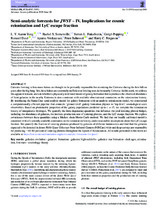| dc.contributor.author | Romeel, Dave´ | |
| dc.contributor.author | Yung, Aaron | |
| dc.contributor.author | Somerville, Rachel | |
| dc.date.accessioned | 2021-02-09T09:34:33Z | |
| dc.date.available | 2021-02-09T09:34:33Z | |
| dc.date.issued | 2020-06-20 | |
| dc.identifier.citation | Romeel, D; Yung, A; Somerville, R . 2020. Semi-analytic forecasts for JWST – IV. Implications for cosmic reionization and LyC escape fraction. Monthly Notices of the Royal Astronomical Society.496(4):4574-4592 | en_US |
| dc.identifier.uri | http://doi.org/10.1093/mnras/staa1800 | |
| dc.identifier.uri | http://hdl.handle.net/10566/5871 | |
| dc.description.abstract | Galaxies forming in low-mass haloes are thought to be primarily responsible for reionizing the Universe during the first billion
years after the big bang. Yet, these haloes are extremely inefficient at forming stars in the nearby Universe. In this work, we address
this apparent tension, and ask whether a physically motivated model of galaxy formation that reproduces the observed abundance
of faint galaxies in the nearby Universe is also consistent with available observational constraints on the reionization history.
By interfacing the Santa Cruz semi-analytic model for galaxy formation with an analytic reionization model, we constructed
a computationally efficient pipeline that connects ‘ground-level’ galaxy formation physics to ‘top-level’ cosmological-scale
observables. Based on photometric properties of the galaxy populations predicted up to z = 15, we compute the reionization
history of intergalactic hydrogen. We quantify the three degenerate quantities that influence the total ionizing photon budget,
including the abundance of galaxies, the intrinsic production rate of ionizing photons, and the LyC escape fraction. We explore
covariances between these quantities using a Markov chain Monte Carlo method. We find that our locally calibrated model is
consistent with all currently available constraints on the reionization history, under reasonable assumptions about the LyC escape
fraction. We quantify the fraction of ionizing photons produced by galaxies of different luminosities and find that the galaxies
expected to be detected in James Webb Space Telescope Near-Infrared Camera (NIRCam) wide and deep surveys are responsible
for producing ∼40–80 per cent of ionizing photons throughout the Epoch of Reionization. | en_US |
| dc.language.iso | en | en_US |
| dc.publisher | Oxford University Press | en_US |
| dc.subject | galaxies: evolution | en_US |
| dc.subject | galaxies: formation | en_US |
| dc.subject | dark ages | en_US |
| dc.subject | reionization | en_US |
| dc.subject | first stars | en_US |
| dc.title | Semi-analytic forecasts for JWST – IV. Implications for cosmic reionization and LyC escape fraction | en_US |
| dc.type | Article | en_US |

